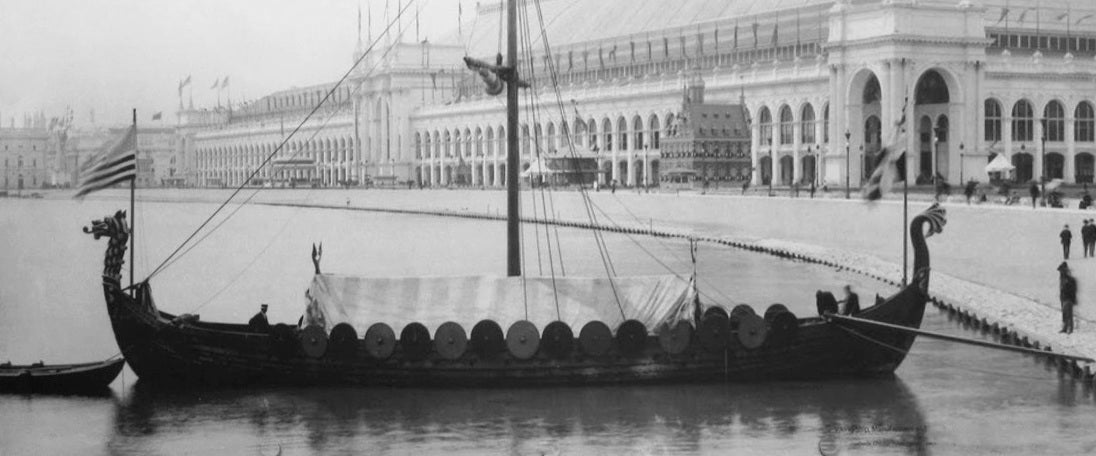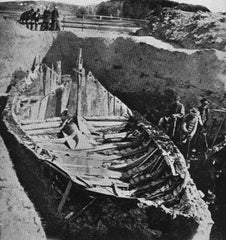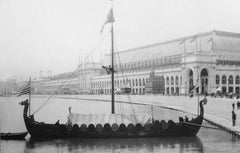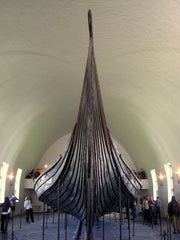on all orders over $100
on all orders over $100

As a seafaring people the Vikings were heavily reliant on their ship building skills to maintain their way of life. Due to the geography of their native terrain, the numerous waterways and lakes and the long coastline it was vital for the Scandinavian people to have a strong boating tradition if they wanted to be connected to the outside world. Fortunately for them they had an abundance of the raw resources required to build the great ships that they became so famous for, such as timber and iron.
They famously travelled to the British Isles and Northern France to raid and settle, along with being the first Europeans to settle in Iceland, Greenland and even travelled as far a field as North America and the Middle East. Their culture was based around international trade, travelling to new lands and the raiding and pillaging that they have become so famous for, all of which required them to have a mastery of the seas.
The Scandinavian people prior to the Viking Age had already been building ships for centuries, however most of these were simple rowing boats, which was one of the more common methods in ancient times. Once they began incorporating sails on their vessels this changed their culture completely and the Viking Age began soon after. With these new ships they could now sail further afield, allowing them to transport large numbers of warriors and conduct raids on the eastern coast of the British isles and the northern coast of France. The ships played such a crucial part in Norse culture in the Viking Age that without them it might never have had such a profound impact on medieval Europe.
Viking Age ships were often known as 'longships' due to their design and characteristically long hull. At their largest some of these ships could carry up to eighty warriors, however smaller ships were much more common due to the fact they were fast and more effective at delivering surprise attacks during raids.
The ships were able to sail fast when the wind was on their side, however when the wind was against them they could still progress, just at a much slower pace. It is though that they would resort to the more traditional method of rowing at times such as these.
The Knarr was a small boat which was not considered to be a longship. It was shorter and wider by design than other norse vessels and was primarily designed for cargo and long voyages. This was the primary design used by the Vikings on their excursions over the perilous North Atlantic oceans en route to Greenland, Iceland and Vinland.
When making new settlement it would be vital to import supplies of food, timber, wool and of course weaponry and armour. This ship would also be used for long distance trade between different Viking settlements and their allies.
Although the Karve was considered to be a type of longship it was very similar to the aforementioned 'Knarr' due to its role being primarily for trade transport and fishing rather than warfare, however there is evidence that they were sometimes used for this purpose. Another similarity was that the Karve had a wider hull when compared to other longships that were designed specifically for battle.
The main advantage of this type of ship over others was its ability to traverse shallow waters, this meant they could be used for coasting, where larger ships could not.
This was thought to be the smallest of the longship designs which were specifically designed for warfare. This ship had a capacity of approximately 40 crew and was probably the most commonly used in Viking Age Scandinavia.
King Canute, the ruler of the so called 'North Sea Empire' was said to have more than a thousand of these ships under his command. This ship design was thought to have originated in Norway and was designed for deep water sailing, not suitable for the shallow coastlines where the Karve would have been better suited.
The skeid was the largest warship used by the Norsemen, they could be 30 meters in length and manned by a crew of as many as 80 men. This was the quintessential Viking war ship, often being associated with speed, its 60 oars allowed it to move quickly even against the wind. A ship of this size would have been magnificent, however due to it's size and the amount of work involved the Skeid was probably rarer than the smaller and easier to produce Snekke.
Also known as the 'dragon ship' was a legendary type of ship which is mentioned in some of the Norse Sagas. They were described as being large, similar in size to the Skeid, however they were distinct for their ornate carvings, usually depicting dragons or mighty serpents. These majestic vessels were designed for one purpose alone; raiding.
One of the most notable mentioned in Norse texts was the drakkar belonging to the Norwegian King Harold Fairhair. To this day no archaeological find has unearthed a ship that would seem to meet the descriptions of the mighty dragon ships which were present in the sagas, however there have been various drawings in historical artefacts and one is even shown on the emblem of the city of Bergen in Norway.
Making one of these ships was quite a task, all of the parts had to be made from scratch including the wooden planks, nails, oars, and rope. This was an extremely time consuming process which required hours upon hours of hard work. The Vikings would make their wooden planks by splitting the wood along the grain using wedges and axes.
Check out the video below for a demonstration of this technique:
These planks would then be arranged in order to form the hull of the ship and each one would overlap slightly. They would then be joined together using iron nails and the gaps would be filled in with cotton to make it water tight.
The material of choice for ships was Oak, due to it strong and flexible properties, however due to the climate this would only grow in the southern regions of Scandinavia, therefore other types of wood were sometimes used when Oak wasn't readily available.
There were numerous famous ships mentioned in Norse sagas, one of the most prominent being the magical 'Skidbladnir', which belonged to the Vanir God, Frey. This great vessel was crafted by two dwarfs and was enchanted with the ability to sail over land, air and sea. It was said to have the ability to travel between worlds and was used by the Gods to ferry the souls of the dead to the afterlife. It also had the ability to be folded up, like a cloth, and fit into ones pocket. In the Prose Edda Skidbladnir was described as the greatest of all ships, which is understandable given it unique powers.
Although Frey's ship was said to be the finest ship, there was also another prominent vessel in Norse Mythology which had a darker role to play in the sagas. The largest ship, known as 'Naglfar', was made entirely of human fingernails and belonged to Muspelheim; the realm of fire. In the prophecy of Ragnarok it was with this ship, captained by Loki, that the forces of chaos would ferry their army of giants and monsters to do battle with the Norse Gods for the last time.
There have been numerous historical finds where Viking age ships are either fully or partially intact. These help to give us an idea of the real size and design of their vessels and also build replicas from the same materials in order to test their functionality.
This ship was found in Gokstad, Norway, at a Viking age burial site and is currently being displayed in Oslo at the Viking Ship museum. The Ship was discovered in 1880 when a farm owner started digging on his land after hearing rumours of a potential historical site in the area.

The Gokstad Ship being excavated - Gokstad Mound, 1880
The ship itself is more than 20 metres in length and was thought to be designed for battle, trade and the transportation of goods and people between different Viking settlements. It was made primarily of Oak and is constructed in a 'lapstrake' design, which is a method of shipbuilding where the panels of the hull overlap. The ship was primarily a sailing ship, however like many viking vessels it had the ability to be rowed too. Modern historians estimate that the crew would have numbered between 40-70 men and had the capacity to be rowed by around 32 of them at a time.

A replica of the Gokstad Ship in Chicago - World's Columbian Exposition, 1893
It was constructed during 9th Century AD during the reign on Harald Finehair, which was a region of great expansion and prosperity for the Vikings throughout the British Isles, especially in Ireland.
The Oseberg ship is one of the most intact surviving ships that have been found to date. It was discovered in 1904 in Tønsberg, Norway on a piece of land belonging to the Oseberg Farm. The ship was thought to have been built around 800AD, it was discovered with two female skeletons and numerous grave goods which were all part of a burial mound.

Oseberg Ship in the Viking Ship museum - Public Domain
This ship is also made of Oak by using a lapstrake design to overlap the panels. It is approximately 20 meters long and 5 meters wide with 15 ore holes in the side indicating that a maximum of 30 people could row, however it also included a mast and sail.
The detailed wooden engraving on this ships bow and the other items found in this burial site was so influential that it has become known as Oseberg style. This is considered one of the most prominent and earliest styles of art from the Viking Age.
If you enjoyed this article or wish to add anything then please leave a comment below.
Check out some of our Viking Ship Jewelry.
Leave a comment